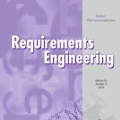Contemporary software systems (CSS), such as the internet of things (IoT) based software systems, incorporate new concerns and characteristics inherent to the network, software, hardware, context awareness, interoperability, and others, compared to conventional software systems. In this sense, requirements engineering (RE) plays a fundamental role in ensuring these software systems' correct development looking for the business and end-user needs. Several software technologies supporting RE are available in the literature, but many do not cover all CSS specificities, notably those based on IoT. This research article presents RETIoT (Requirements Engineering Technology for the Internet of Things based software systems), aiming to provide methodological, technical, and tooling support to produce IoT software system requirements document. It is composed of an IoT scenario description technique, a checklist to verify IoT scenarios, construction processes, and templates for IoT software systems. A feasibility study was carried out in IoT system projects to observe its templates and identify improvement opportunities. The results indicate the feasibility of RETIoT templates' when used to capture IoT characteristics. However, further experimental studies represent research opportunities, strengthen confidence in its elements (construction process, techniques, and templates), and capture end-user perception.
翻译:现代软件系统,如基于事物的互联网(IoT)的软件系统,与常规软件系统相比,包含网络、软件、硬件、背景意识、互操作性等所固有的新问题和特点,从这个意义上讲,要求工程(RE)在确保这些软件系统的正确发展、寻找商业和终端用户需要方面发挥着根本作用;文献中提供了几种支持可再生能源的软件技术,但许多软件技术并不涵盖所有基于事物的互联网(IoT)软件系统的特殊性。本研究文章介绍了RETIoT(基于事物的软件系统互联网所需的技术工程技术),旨在提供方法、技术和工具支持,以编制IoT软件系统要求文件。它由IoT情景描述技术、核查IoT软件系统情景、建设过程和模板的核对清单组成。IoT系统项目进行了可行性研究,以观察其模板并查明改进的机会。研究结果表明,在使用RETIoT模板来获取IoT特性时,它的可行性。但是,进一步的实验性研究展示了研究机会,加强其组成部分中的信任模板和最终的模板。





